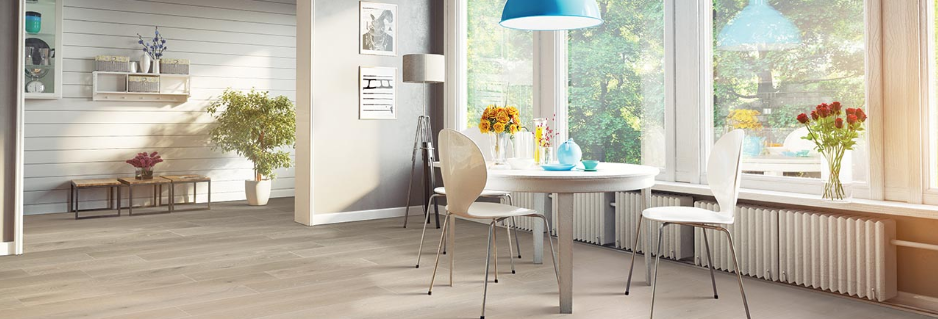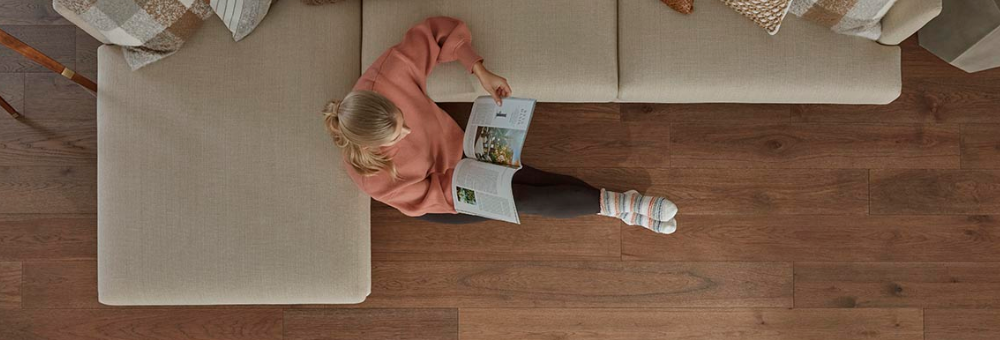Hardwood floors are the classic choice for homeowners looking for beautiful flooring. Wood floors instantly add warm, rustic charm and natural beauty wherever they are installed. But if you’re considering hardwood floors for your home, the options can be overwhelming. How do you know which to select for your home? And what is the real difference between solid hardwood and engineered wood flooring? The good news is that you don’t have to choose on your own. Below, we’ll outline the difference between the two so you can make an informed decision.
Similar but Different
Both solid hardwood planks and engineered wood planks are made from 100% real wood. And both types are capable of delivering a beautiful visual. However, they have major differences, including construction, stability, installation and, of course, cost.
Construction
Solid hardwood planks are, like the name suggests, created from a single piece of solid wood. Engineered wood flooring is also made of genuine wood, but it’s made with multiple layers, including a hardwood or plywood core and topped with a thin layer of hardwood veneer. This layered construction creates stability that is superior to ordinary hardwood flooring, but the thin veneer limits how often they can be refinished.

Stability
Both solid hardwood and engineered hardwood will provide durability and toughness in active homes. Solid wood flooring is inherently durable, but because of its tendency to expand and contract in response to different temperature and humidity levels, it must be permanently nailed or glued to the subfloor. Engineered wood flooring can have greater dimensional stability in extreme temperatures, which provides slightly more resistance to buckling or rippling. Not all engineered hardwoods offer the same stability, so it’s important to consider the climate of where you live and pay close attention to the construction of the product you choose.
Installation
Where are you installing your new floors? Solid hardwood will expand and contract with changes in temperature and moisture, so they are not recommended for basements. Also, the installation method for solid hardwood takes some consideration. Solid hardwood flooring must be glued, nailed or stapled to a wood subfloor. Since engineered wood is less likely to buckle, gap or react to heat or temperature change, securing it directly to the subfloor may not be necessary. In fact, some engineered wood can even be installed below and over radiant heat. Regardless of whether you end up with a solid or engineered wood floor, it’s worth the investment to rely on quality installation experts to ensure a stress-free flooring experience.
Cost
Your budget will help inform your choice between engineered and solid hardwood flooring. Generally speaking, engineered wood flooring is less expensive than solid hardwood, without sacrificing quality. Ultimately, the quality and species of wood will be the biggest determinants of the price of new solid hardwood floors. Exotic solid hardwood species can be much pricier than engineered hardwood.
Maintenance
Due to the thickness of each solid plank, classic hardwood floors can last many, many years. If scratches, dents, and stains accumulate over time, the floors can simply be sanded down and refinished. As mentioned before, the thin veneer is not designed to be sanded down and refinished—instead, it’s designed to hold up against scratches and dents. This can make engineered hardwood inherently lower maintenance than solid hardwood floors. Of course, durability varies from one product to the next so be sure to consider your family’s lifestyle when you’re choosing.

Engineered Wood Flooring vs Solid Wood: The Bottom Line
Whether you choose solid hardwood or engineered hardwood floors, you’re going to get a long-lasting, beautiful floor that adds warmth and style to your home. So make your checklist, prioritize the characteristics you want, set your budget parameters and visit your local retailer. Your gorgeous new floor awaits!

